Art reviews: Platform 2020 | Robert McAulay | Ade Adesina
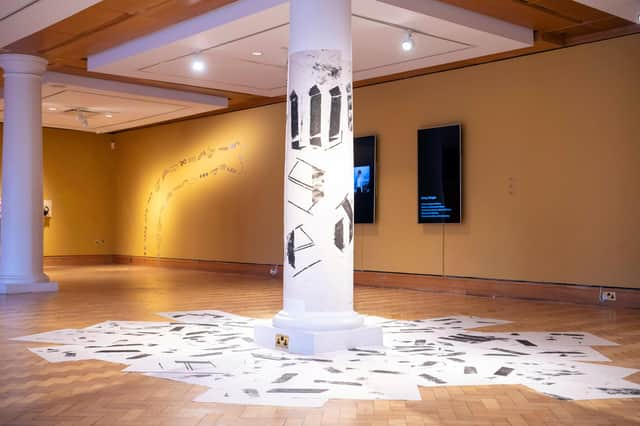

Platform: 2020, City Art Centre, Edinburgh ***
Robert McAulay: Revisiting the Estate, Kilmorack Gallery, near Beauly ****
Ade Adesina: New Leaves, Kilmorack Gallery, near Beauly *****
Advertisement
Hide Ad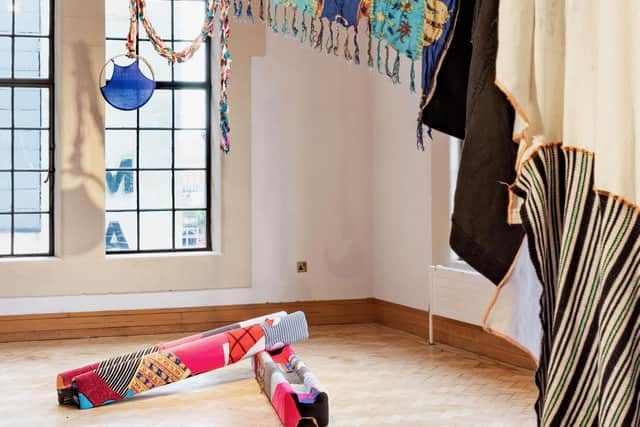

Just before lockdown, artist Ruth Ewan and curator Sophia Hao chose the participants for this year’s Platform, Edinburgh Art Festival’s annual exhibition which supports four emerging artists to make new work. While the festival itself was cancelled – the memory kept alive by a handful of outdoor commissions and a weekly artist portfolio feature in the pages of The Scotsman – EAF pledged that Platform 2020 would go ahead in the autumn providing vital support to four young artists in a year which has been so difficult for so many.
The four bodies of work have been thoughtfully woven together in the fourth floor gallery at City Art Centre by curator Abigail Webster. While each is distinct, they also talk to one another in threads of thematic and aesthetic connection.
However, there are ways in which the exhibition exposes the weakness of what has become a common way of working among young artists. While working across a range of media is nothing new, it now seems fashionable to engage with as made modes as expression as possible in the same body of work. Artists will explain that they work in “printmaking, sculpture, installation, filmmaking and writing” and often seem to do all of the above in the same project. The danger is a lack of focus, the sense that a viewer doesn’t know where to look (or listen, or read) in order to catch the impact of what the artist is saying.
Rhona Jack’s work stands out. Part of her submission to RSA New Contemporaries in 2018 involved building a loom which she has now used to create a series of handwoven rugs. Above the rugs hangs a sculpture made from discarded clothing, trousers, t-shirts, tops, stitched together, woven into ropes, stretched over metal hoops.
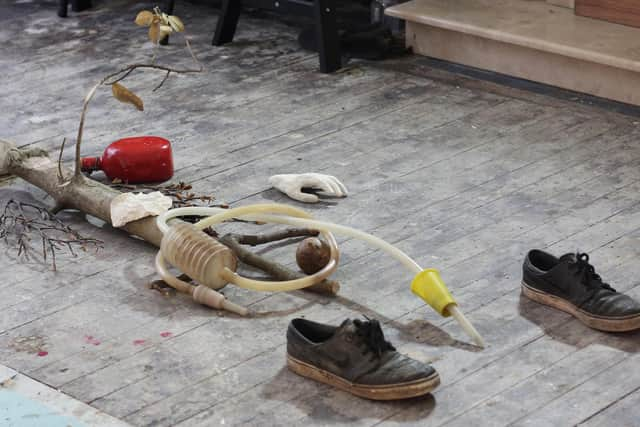

The work becomes a conversation between the hand-made and the mass produced, emphasising the tactile nature of craft while reminding us that working in a garment factory requires skill too, and that both involve a certain amount of monotony. And while we bemoan the environmental and economic impact of mass produced low-cost clothing, these recognisable garments remind us they might still become cherished wardrobe staples which then have a second life via a charity shop, or as art. Jack’s work opens up big themes while being visually impactful: it takes us from A to B.
That journey is more problematic in the work of the other three artists. While the accompanying booklet explains the themes they are working with, it is not always easy to arrive at those themes by looking at the work. Susannah Stark is interested in habitation in Scotland, from ancient brochs to the history of the Clearances, and the tourist-focused images used to sell Scotland today. All this is fascinating, but I’m struggling to get there from her installation of projected images and collage of sounds: field recordings, fragments of song and conversation.
Advertisement
Hide AdHer floor-based sculptures – arrangements of found objects from the beach which resemble human bodies – are surely powerful. A driftwood spine, sponges for internal organs, a coiled plastic tube for an intestine and a pair discarded trainers work together to evoke the image of an ancient skeleton from an archaeological dig, even a scene of crime, but they seem incidental in the work, as if no one quite realised their power.
Mark Bleakley, whose practice melds choreography and visual art, is interested in weight, how human beings lend weight (literally) to something by going on a protest march or taking part in a sit in. An installation of paper which has been block-printed (by leaning, physically, on the inked blocks) takes us part-way there, but the two films muddy the waters. One shows fragments of movement workshop Bleakley organised, the other collages found footage, words, music and elements of games show Jeopardy (“what is millennial guilt? what is climate crisis? what is pandemic?”) Amid all these images, words and themes, we’re left wondering where to focus, wondering where the work is putting its “weight”.
Advertisement
Hide Ad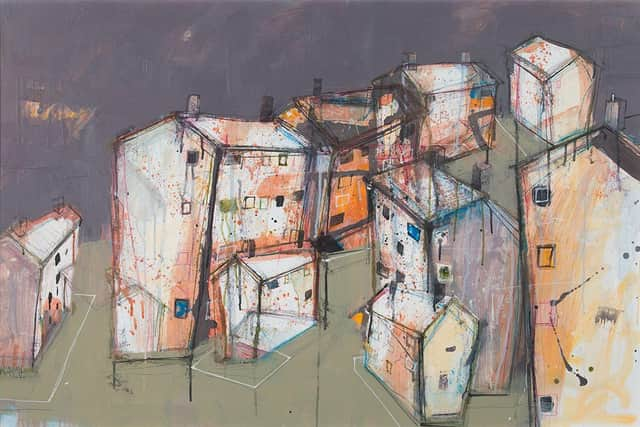

Rabindranath A Bhose’s installation looks, at first glance, exactly like a path edged with directional symbols – arrows and pointing fingers, curving from the floor on to the wall. A little homework reveals it’s actually an elephant’s trunk, an allusion to the Hindu god, Ganesh and the artist’s quest for a personal spirituality. The rest of the work is a long piece of writing, published in a booklet and read aloud by Bhose’s partner, a stream of consciousness piece about queer identity, the body and bananas. But where all those directional symbols are leading us is unclear.
The two artists currently showing at Kilmorack Gallery have, by contrast, become masters in their chosen medium, and now have this at their disposal to explore what they want to explore. Place and mood have long been important in Robert McAulay’s paintings, but rarely as specifically or as evocatively as now, when he turns his attention to the Glasgow housing estate where he grew up.
Often, the perspective in these works is looking down, as from a high-rise window, and yet McAulay manages to make the low-rise tenements loom and disorientate. Buildings are captured as geometry, green areas patterned with stylised trees. Working in acrylic on a gesso ground, he uses colour well, windows glow orange at night, shadows are cast in purple or turquoise. This feels like a landscape revisited in memory, not autobiographical exactly, but full of feelings and energy, a layered exploration of a place once called home.
Meanwhile Ade Adesina continues his journey to becoming one of the most distinguished printmakers of his generation. Nigeria-born and Aberdeen-based, he seems to possess endless patience (the infinite detail on those two metre-long linocuts), matchless skills in draughtsmanship and limitless energy in pursuing collaborations and ideas: works in this show are the result of collaborations with June Carey, David Mach and Ian Burke among others. While some of these pairings are more successful than others, they all reflect a spirit of relentless exploration, while continuing to draw on his own powerful lexicon of symbols and images.
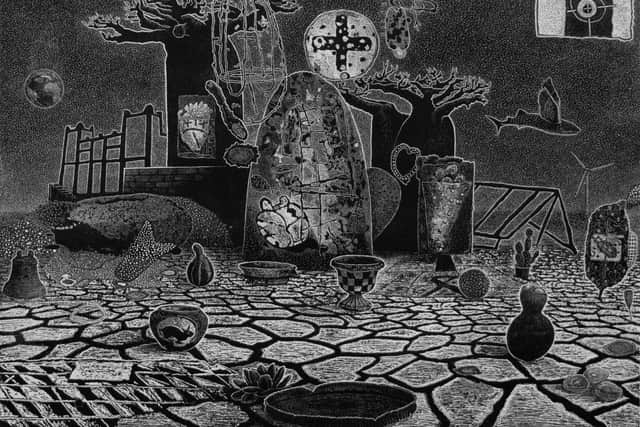

Time is a constant theme, appearing in clock faces and hour glasses, and in disrupted landscapes: deserts and floods, the impact of human abuses on the planet as time runs out. Whales grow wings, fish try to escape from the goldfish bowl, baobab trees keep time, fantasy cities fuse New York, London and Lagos. In Trickle (a collaboration with Mach), people play in rockpools in the upper bulb of a huge hour glass, while in the lower one they flee from the detritus of modern civilisation.
Other works don’t yield to such easy interpretation, the meshing of natural, mechanical and mythological is more dense, more opaque. But one is never in any doubt that Adesina knows what he means, or that he’s communicating it with precision, consummate skill and the boundless inventiveness of his imagination.
Advertisement
Hide AdPlatform 2020 runs until 29 November, visitors must book in advance on www.edinburghmuseums.org.uk; Robert McAulay and Ade Adesina run until 5 December, www.kilmorackgallery.co.uk
A message from the Editor:
Thank you for reading this story on our website. While I have your attention, I also have an important request to make of you.
Advertisement
Hide AdThe dramatic events of 2020 are having a major impact on many of our advertisers - and consequently the revenue we receive. We are now more reliant than ever on you taking out a digital subscription to support our journalism.
To subscribe to scotsman.com and enjoy unlimited access to Scottish news and information online and on our app, visit https://www.scotsman.com/subscriptions
Joy Yates, Editorial Director